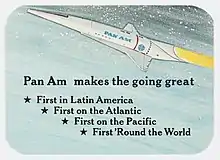First Moon Flights Club
The First Moon Flights Club was a marketing campaign of American airline Pan Am that ran between 1968 and 1971. Self-described as a space tourism program, it was essentially a "waiting list" of people interested in taking commercial flights to the Moon. While some considered it to be a tongue-in-cheek campaign,[1][2] Pan Am publicly insisted that the program was legitimate.[3]

Origins
According to popular legend, the program was conceived in 1964, when Austrian journalist Gerhart Pistor demanded a flight to the Moon at a Vienna travel agency.[4] The travel agency accepted his deposit of 500 Austrian shilling, and forwarded his request to Pan Am and Aeroflot.[5] At Pan Am, the request was eventually forwarded to founder Juan Trippe, who saw an opportunity in capitalizing on the obsession with human spaceflight.[4] Pistor's reservation was accepted two weeks later,[5] and was told that the first flight was expected to depart in 2000.[6]
Operation

The program was established in 1968,[3] and no deposits were required for reservations.[3] Reservations did not include the fare, which Pan Am said was "not fully resolved, and may be out of this world."[7]
At the beginning of its operation, the program received only a small flow of requests. The popularity of the program was bolstered when the science fiction film 2001: A Space Odyssey was released in 1968. The movie, featuring a fictional Pan Am "Space Clipper", led some audiences to believe Pan Am's program was legitimate.[4] The first major surge of sales occurred after the successful Apollo 8 flight in 1968.[4] Trippe phoned ABC to make it known that the airline was keeping a list of people interested in a commercial flight to the Moon. After the publicity stunt, the company received "a flurry of requests".[1] The program was also promoted on radio and TV spots.[8] By July 20, 1969, during the lunar landing of Apollo 11, Pan Am's program had 25,000 reservation requests.[1] The successful Moon landing further increased sales.[4]
Reservers were given a membership card issued at no cost.[4][6] The cards were signed by Pan Am's vice president for sales, James Montgomery, and the "Space Clipper" was featured on the back of the card. A serial number was printed on the card, which reflected the reserver's position on the waiting list.[7] 100,000 cards were printed in total.[3]
The success of the program attracted competitor Trans World Airlines to maintain a similar waiting list,[1] who ended their program after receiving around 6,000 names and public interest had waned.[3]
Its waiting list was closed on March 3, 1971,[5] when the program became an administrative burden during an era of financial troubles at the airline.[3][6] By then, the list had 93,000 names from 90 countries, and included many public figures such as Ronald Reagan, Barry Goldwater, Walter Cronkite and George Shapiro.[1][3] As late as 1989, Pan Am maintained that the program was legitimate,[1] and that the memberships would eventually be redeemed.[8] A Pan Am spokeswoman called the program "a little off-scheduled", but promised that they were "keeping the list in an archive and will pull it out when—note that I didn't say if—the airline starts regular service."[5] The airline declared bankruptcy in 1991, formally ending the program.[1][6]
Citations
References
- Blum, Sam (2019-02-28). "When Pan Am Promised to Fly Us to the Moon". Popular Mechanics. Archived from the original on 2021-01-17. Retrieved 2021-03-23.
- Dabbs, Alistair (2019-07-19). "Guess who reserved their seat on the first Moon flight? My mum, that's who". The Register. Archived from the original on 2020-11-08. Retrieved 2021-03-23.
- Dallos, Robert E. (1985-02-10). "Pan Am Has 90,002 Reservations : Public Interest Grows in Flights to the Moon". Los Angeles Times. Archived from the original on 2020-02-21. Retrieved 2021-03-23.
- "Pan Am moon flight booked solid". The Daytona Beach News-Journal. Daytona Beach, Florida. 1989-07-22.
- Lengeman, William, III (2007-08-31). "Space Tourism's First Small Steps". Air & Space Magazine. Archived from the original on 2021-03-23. Retrieved 2021-03-23.
{{cite web}}: CS1 maint: multiple names: authors list (link) - "Card, Club, Pan Am "First Moon Flights"". National Air and Space Museum. Smithsonian Institution. Archived from the original on 2021-02-15. Retrieved 2021-03-23.
- "Were You a Member of the "First Moon Flights" Club?". National Air and Space Museum. 2015-07-31. Archived from the original on 2021-02-27. Retrieved 2021-03-23.
- Wade, Tony (2019-07-15). "Back in the Day: Viewing the 1969 moon landing through a local lens". Daily Republic. Archived from the original on 2019-07-16. Retrieved 2021-03-23.